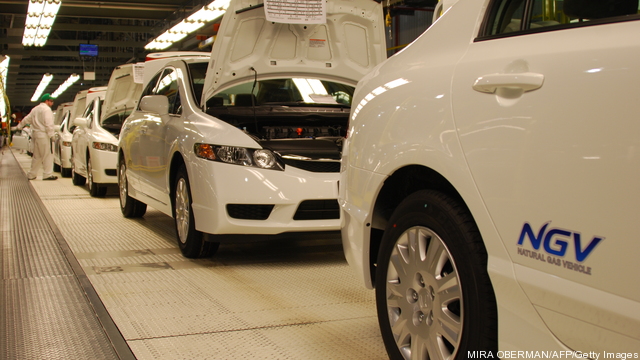
Government can help the natural gas vehicle industry to gain a foothold in the market, but isn’t likely to work as a stimulus in the long run because many executives distrust its abilities to sustain support, according to the head of a leading maker of natural gas engine technology.
David Demers, chief executive of Westport Innovations said incentive programs are always fragile because they are subject to shifting political winds, and can cause serious disruption if they are withdrawn, so business leaders are more inclined to build their models on the basis of market forces.
That’s why he sees the NGV market growing steadily as vehicle owners, particularly trucking companies, recognize the significant cost benefits of using natural gas instead of gasoline or diesel.
“It’s going to happen organically when it makes economic sense,” Demers told Breaking Energy in an interview during a visit to New York. “Unless there is a very clear long-term commitment to those incentives, most businesses are skeptical and simply don’t approve long-term plans that depend on them.”
Westport is “grateful” for the support it has had from early champions of natural gas such as the South Coast Air Quality Management District in Los Angeles, Demers said, but the industry is moving toward self-sufficiency.
“The industry should be able to move on from here without a big fight at a time when government is distracted and polarized over much bigger issues,” he said.
Trucking companies are likely to adopt natural gas engines more quickly than car owners because trucks are more heavily dependent on fuel prices, Demers argued. He cited Waste Management, where the majority of truck purchases are now natural gas.
There’s also a “very significant” opportunity for NGVs in the passenger car market, which could be larger than that for electric vehicles.
But for now, the U.S. lags the rest of the world in NGV adoption. He contrasted the U.S. market, where only two vehicles – the Honda Civic GX and the Ford F250 – have natural gas engine options, with that in Europe where there are more than 30 gas-driven models available, and many more refueling stations, due in part to active government support for the infrastructure in some countries.
China, too, is ahead of the U.S. in encouraging growth of the NGV market, with some 350 filling stations for liquefied natural gas – that used by long-haul truckers — contrasting with around 70 that are expected to be operation in the U.S. by the end of 2012, according to Westport statistics.
Still, the number of U.S. LNG stations is up sharply from only four a year ago, Demers said.
That’s partly the result of investment by Clean Energy Fuels, a former joint venture partner with Westport, which has led the cause of converting the U.S. long-haul trucking fleet to natural gas.
Among the bright spots in the outlook for the U.S. NGV market is the “return to base” sector in which fleet users such as buses and trash trucks can refuel at one location rather than having to rely on a network of filling stations, Demers said.
The long-haul trucking market, too, could run on natural gas with relatively few refueling locations because 90 percent of its vehicles run on fixed routes such as the “Texas triangle” of Houston, Dallas and San Antonio, he said.
But for now, the scarcity of LNG filling stations is a major challenge facing the natural gas trucking industry.
“People are saying ‘I don’t want the truck just yet until I can see where I’m going to fill up'”, said Darren Seed vice president of investor relations and communications for Vancouver, B.C.-based Westport.
The infrastructure problem was one reason for Westport’s $32.5 million third-quarter loss, sharply higher than the $13.2 million loss reported for the year-ago period. Consolidated revenue also shrank, by 6% in the third quarter but grew by 65% to $270.8 million in the 12 months to Sept. 30, the company reported.
Seed attributed the loss in part to the deferral of plans by major energy companies including Shell, EnCana and Chesapeake Energy to build refueling stations. Also weighing on Westport’s performance was the struggling European economy where Westport sells to seven out of the top 10 engine makers, and the last-minute decisions by some original equipment manufacturers to defer or cancel plans to build “a few hundred” engines with the company’s natural gas technology, Seed said.
Because of the high cost of LNG tanks and low production volumes, customers pay a premium of $40-$50,000 for a truck powered by a Westport-fitted engine compared with a conventional diesel model. But the owner of the average U.S. truck covering 80,000 miles a year over six or seven years can recoup the outlay in about two years given the low price of natural gas, Demers said.
“There’s so much money to be made between the price of methane and the price of diesel fuel,” he said.
While natural gas prices are likely headed up from their current level of around $3.50 per million btus on increasing demand from industry, transportation and power generators, abundant new domestic supply is likely to cap the rise at between $4-5, a range that Demers called “sustainable”.
